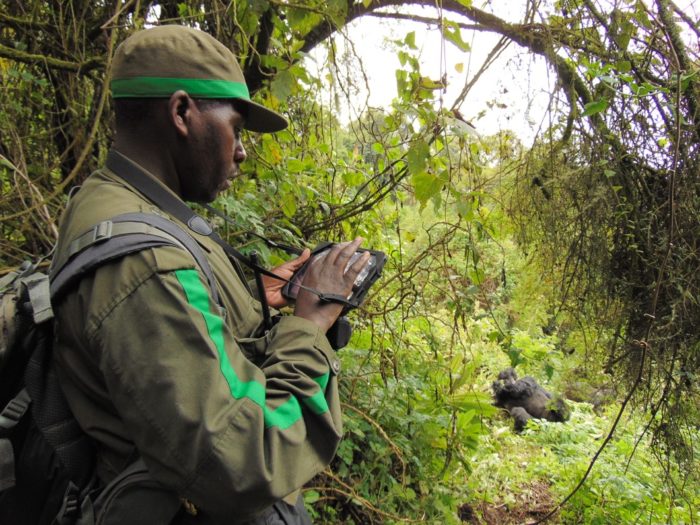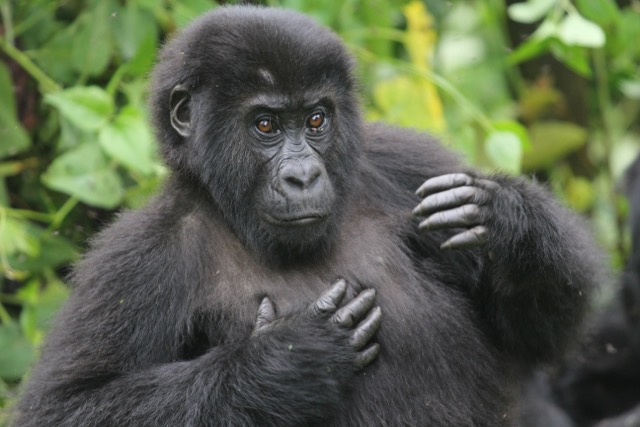- Animal Observer is a free, new iPad app that helps researchers collect animal behavior data such as activity, diet and social interactions.
- Developed by the Fossey Fund and initially designed for gorillas, the app is now customizable to a variety of observation types and species.
- GPS capabilities allow the app to record spatial positions of the animals being observed, providing critical data for social network and spatial analyses.
- Animal Observer is perhaps best applied for studying species that have a strong group dynamic or social structure.
In recent years, technological innovations like camera traps and GPS collars have revolutionized wildlife research. However, when it comes to collecting field observations, scientists frequently still use the old-school method of a pen and a notebook. But maybe not for much longer.
While other handheld data collection tools – including CyberTracker, Open Data Kit and SMART – already help rangers and social scientists collect data, none tailor to the spatial and behavioral dynamics of wildlife, especially those in social groups.
Enter Animal Observer, a free, new iPad app to help animal behavior researchers record observations of wildlife in the field. The Dian Fossey Gorilla Fund, in partnership with Oracle, initially designed the app for gorillas, but they have since added new features and made it customizable to broaden its applicability to a wide variety of species.

About the App
Animal Observer has three main areas: Focal Animal Sampling, Scan Sampling and Map Mode.
The Fossey Fund uses Animal Observer on a daily basis to study and monitor the behavior, movements, social interactions and health of gorillas, which live in family groups. “This app allows you to know about who gets along with whom, who doesn’t associate with whom and what the overall social network of the animals in the group looks like,” says Damien Caillaud DVM, Ph.D., who began developing this app three years ago.
The user drags names of registered individual animals (e.g. gorillas in a group) from the ID Bank Panel onto the scene to record their relative location. By simply clicking on each individual, the user can then select an activity (e.g. feeding) from a pre-programmed list. To record social interactions between animals, the user can drag a finger between two individuals to bring up a list of actions (e.g. mating).

The app can also collect text and a variety of media files, including photos, videos and audio recordings, as supplementary information. The app sends an alert 20 seconds before the next scheduled scan time, which allows researchers to put the iPad in standby mode to conserve battery life between observations and replaces the need to frequently set alarms on a stopwatch or timer.
The app is GPS enabled and works in conjunction with the iPad’s compass, which means that data collected can be georeferenced and displayed on a map. For example, it can record the locations of all individuals during a scan, which can provide insight into which individuals lead the group and which ones trail behind. This geographic data can later be incorporated into GIS software for spatial analyses if desired.
Easy data collection
Digitizing data collection also helps circumvent some typical challenges associated with old-fashion methods, such as typos, transcription errors and incorrect dates and times. Moreover, the app is more time-efficient; data can be exported easily and quickly into a database, a big improvement on traditional methods that required manual entry from field notes.
Although the app was developed with researchers in mind, it can be used by teachers, students, wildlife enthusiasts, or anybody else who is interested. The app comes with a gorilla study protocol, which acts as a tutorial to help new users understand how to navigate the software, record observations and export data.

The Animal Observer interface was designed to allow researchers to record information quickly and easily to match the speed at which animals change locations or activities. “Animals typically move fast and switch activity frequently, often every few seconds or so. Being able to record social behaviors and animal activities really fast is very important,” Caillaud remarked.
“All the data are collected on the same screen and do not require typing anything on a keyboard. For example, to record a social interaction between two individuals, such as Animal A is grooming Animal B, all you need to do is drag your finger between the icons representing both animals on the screen. It only takes a second and is much faster than having to pick animal A and animal B in a long list of individuals,” Caillaud explained.
What can it be used for?
The app can record the GPS coordinates of every collected data point, enabling users to map and spatially analyze the behaviors they observe. “Animal Observer is also the only application that we are aware of that can record the spatial position of all the animals you’re observing. Such data are critical to perform social network analyses,” said Caillaud. This feature can help researchers answer questions such as “Does aggression occur more frequently in a particular part of the animals’ territory?” or “Do animals’ diets vary depending on their geographic location?” Users with iPads that lack GPS capability will need to pair the iPad with a small Bluetooth GPS, such as the Garmin GLO used by Caillaud and his colleagues.
The Fossey Fund has more recently expanded Animal Observer to monitor additional species: the beta version was tested by primatologists on chimpanzees, orangutans, baboons, lemurs and others. Caillaud said, “The first version [of Animal Observer] was tested in Congo in May 2015 and was fairly gorilla-specialized. Since then we kept adding features to the app, got feedback from researchers from other field sites who study other species and finally we released the app in August.”

While Animal Observer is perhaps best suited for studying species with a strong group dynamic or social structure, such as primates, elephants and lions, the app can be used to analyze the behavior and health of solitary animals. “You can, for example, use Animal Observer to monitor a leopard’s activity or health throughout the day/night and to collect occasional social behavior data when the focal leopard encounters another leopard,” Caillaud said.
A companion open-source application called Animal Observer Toolbox allows researchers to customize the app to study the interactions between the focal animal and other plant and animal species. AO Toolbox also provides a platform for data visualization, facilitates the conversion of collected data into a CSV file for data analysis and enables users to upload data to a SQL relational database.
iPads only
Animal Observer was launched in September and can be downloaded for free on the iTunes Store, but is currently available only for various iPad models.
“When asked about the kind of electronic device they would like to use to collect animal behavior data in the field, most field researchers chose the iPhone/iPad platform,” said Caillaud. “One key reason is that as iPads constitute a large market, several really good third-party waterproof and sand-proof cases are available for these devices, which is absolutely necessary to monitor animals in a tropical forest or in the desert. It’s not the case of all Android tablets,” he said.

Users will be disheartened to know that the app will not work on their iPhones. Developers decided that a larger screen was needed to accurately record data.
“One of the key features of Animal Observer is its graphical representation of the area where the animals you’re observing are located. Animal Observer lets users place the animals on a small map graphic that’s on the screen which represents the area they are observing. The screen of an iPhone is just too small to do that. The size of the iPad mini screen is ideal,” Caillaud noted.
The developers also chose not to create a version for Android tablets. While this limits the potential audience, one of Caillaud’s top priorities is ensuring that the app is free, so that professors can use it to teach students how to collect animal behavior data and students can download it for their behavior classes. “We want it to also become a teaching tool and not just an app used by a handful of people who can afford it,” Caillaud said. “Making Animal Observer available on the Android platform would cost too much and require us to sell the app.”
What’s next?
Infectious disease is a major conservation issue, especially among great apes like the gorillas that the Fossey Fund studies. Caillaud is developing a module for Animal Observer that will allow users to collect health data on their study animals alongside data on animal activity, diet and social behavior. The upcoming feature incorporates augmented reality for gorilla data collection. “It allows you to have your animal on the screen, visible in 3D, so that you can rotate it and drag skin lesions or wounds to the place on the body where you observe them,” Caillaud said.
Check out the video below to find out more about the Animal Observer app.

